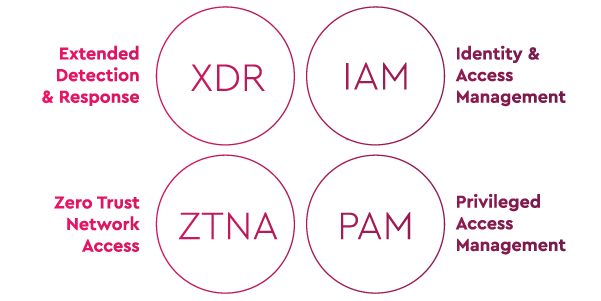IAM has significantly matured over the years, evolving from authentication to sophisticated scenarios to manage complex identity lifecycles and access controls. However, as these solutions have become more advanced, so have the tactics of cyber adversaries, necessitating additional layers of security.
Distology Studios bring together leading cybersecurity technologies that leverage these trends and focus on technologies and vendors who support the Shared Signals Framework (SSF).
A vendor agnostic standard to collect threat intelligence and collaboration among organizations. This framework facilitates the sharing and analysis of security signals and indicators across different entities to better detect, respond to, and mitigate threats.

Components of our Shared Signals Solutions
- IAM, PAM and IGA: All of our solutions tackle the core use cases for organizations today and is the foundation which a security stack sits upon.
- Collective Threat Intelligence: Aggregate threat data from various sources, including internal security systems and external threat intelligence providers. This collective pool of data helps organizations gain a broader and more accurate understanding of emerging threats and attack patterns.
- Collaborative Analysis: Pool and analyze threat signals from different systems in your digital landscape, enabling more effective detection and response. The collaborative analysis helps identify trends, vulnerabilities, and attack vectors that might not be apparent when viewed in isolation.
- Real-Time Alerts and Sharing: The Shared Signals Framework supports real-time communication of security alerts and indicators. This rapid sharing of information allows organizations to respond more quickly to potential threats and minimize the impact of attacks.
- Enhanced Security Posture: Through the use of shared signals and collaborative efforts, organizations can strengthen their overall security posture. The framework helps improve threat detection capabilities, enhance incident response strategies, and reduce the time it takes to address security issues.

Key benefits
- Improved Threat Detection: By integrating signals from multiple sources, the framework enhances the ability to detect and analyze sophisticated threats that might evade traditional security measures.
- Faster Response: Real-time sharing of threat intelligence enables quicker responses to security incidents, helping to mitigate potential damage and reduce recovery times.
- Increased Collaboration: The framework fosters a collaborative environment where organizations can share valuable insights and strategies, contributing to a more resilient and adaptive cybersecurity ecosystem.
- Cost Efficiency: Pooling resources and intelligence helps organizations reduce the costs associated with threat detection and response, leveraging shared knowledge to improve overall security effectiveness.

Who we collaborate with
We are following the OpenID and SSF community to identify the vendors and platforms who are building SSF support into their solutions.
Distology Studios work with Okta, CrowdStrike, and Zscaler as early adopters of the Shared Signals Framework (SSF) by integrating their respective strengths in identity management, endpoint security, and secure access.
- Okta provides robust identity and access management, ensuring secure user authentication and authorization.
- CrowdStrike offers advanced endpoint protection and threat intelligence, detecting and responding to sophisticated cyber threats.
- Zscaler delivers secure access and threat prevention through its cloud security platform.
Together, these solutions create a comprehensive security ecosystem that enhances the effectiveness of SSF by providing integrated visibility, real-time threat detection, and secure access, ultimately strengthening an organization’s overall security posture.
Our website uses only technically necessary cookies. For more information visit our privacy policy.